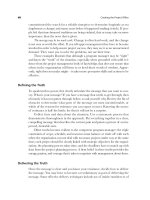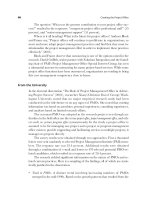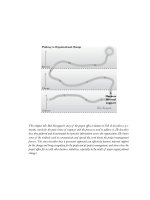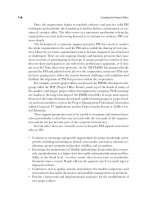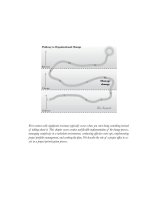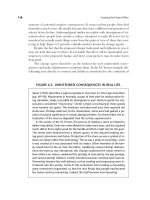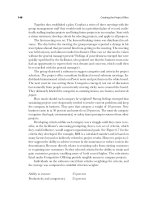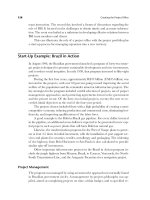Tài liệu Creating the project office 25 doc
Bạn đang xem bản rút gọn của tài liệu. Xem và tải ngay bản đầy đủ của tài liệu tại đây (179.65 KB, 10 trang )
In this chapter we cover how and with whom some companies staff their project offices. What
competencies do they look for? What type of training do project offices at 3M use? Where is the
PO positioned within the organization? What are roles and responsibilities of key players? How
do they work through cultural and other issues together? We also address funding the project of-
fice and the ebb and flow or cyclic nature of operating a project office.
1.
3.
4.
5.
6.
7.
8.
9.
Staff and operate
10.
11.
Refreeze
Change
Unfreeze
2.
Pathway to Organizational Change
219
CHAPTER NINE
IN OR OUT? STAFFING AND
OPERATING THE PROJECT OFFICE
A
re you in or out?” is the tag line of the main character in the movie Ocean’s
Eleven. Dapper Danny Ocean (actor George Clooney) is a man of action,
rolling out his next plan, one that’s never been done before, to do it would be im-
possible, there are a dozen reasons why it won’t work, a smash-and-grab job. Fol-
lowing three rules—don’t hurt anybody, don’t steal from anyone who doesn’t
deserve it, and play the game like you’ve got nothing to lose—Danny orchestrates
the most sophisticated, elaborate casino heist in history. Knowing the difficulties
of pulling off the heist, Ocean and his partner assemble a team, each person
brought on board for a specific expertise and the lure of a big payoff.
The movie director made a conscious effort to have all the actors hang out
together. The movie producer noted that as the actors started spending time to-
gether away from the set, real friendships developed. The actors wanted to go to
work and work and be with one another. The movie’s Web site describes how
much fun everyone had on this movie.
Staffing a project office involves similar challenges, approaches, and desire to
work together. Getting the right people and creating the environment for them to
be successful will make or break a project office.
Y
Competence
Sandberg (2001) writes, “Corporations need to shift the focus of their recruitment
and training programs from flawed attribute checklists toward identifying and, if
necessary, changing people’s understanding of what jobs entail” (p. 28). He iden-
tifies three views of competence at work. Sequential optimizers see their work as a se-
ries of steps and value technical skills the most. Interactive optimizers see activities as
interactive systems and value learning, teamwork, and knowing how performance
categories influence each other. Customer optimizers are similar to interactive opti-
mizers and see goals not through a technical engineering lens but from a cus-
tomer’s viewpoint.
Sandberg’s research at Volvo revealed that customer optimizers were the
most effective at their work while sequential optimizers were the least capable.
Even the reasons given by employees for these assessments differed depending
on how they defined the job. The conclusion to remember when staffing a project
office is that a person’s competence is not easily reduced to a standardized check-
list of skills.
Competent workers see a particular vision of what their work is and why it is
that way. Thus a project office is more effective when the people in it possess not
a litany of project management skills but a clear view of the end result that is
possible and a commitment to doing everything they can to make it happen. Re-
cruiting these people means probing for their understanding of the big picture.
David Frame spent much of his career immersed in issues of project manage-
ment competence. He notes, “Achieving project management competence entails
the concurrent development of individual competence, team competence, and
organizational competence” (1999, p. xii). In his work he explores the issues of
competency and presents checklists of tools that competent project professionals
should master. He also offers an interesting perspective about the demoralizing
220 Creating the Project Office
Establish sense of
urgency— clear danger
• identify competence
• develop program managers
• operate and work together
• define roles and responsibilities
Leading
Organizational
Change
to PBO
Create guiding coalition—
powerful forces
Develop vision and
strategy—focus
Manage the change—
short-term wins, broad-based
action, consolidate gains
Develop broad-based action—
keep moving, implementing
Staff and operate—
In or out?
The tale we tell
Communicate the change
vision—tell the tale
Make change stick—
new PBO culture
effect of clueless managers: “These are men and women who are oblivious to the im-
pacts of their words and actions. Their attempts at humor are offensive. They pro-
vide little feedback about the job performance of their workers, and when
feedback is forthcoming it may entail ad hominem attacks on the employees....
They wear the mantle of captains of industry and issue orders like generals run-
ning a military campaign. Regrettably these orders often have not been thought
through and lead to predictably unfortunate consequences” (p. 39). Frame con-
cludes that it is difficult to see how people who do not understand themselves can
be expected to understand and deal effectively with others.
Beginning project managers may struggle with these issues as part of their
development. They are not the best candidates for a project office. Since the
change agent role is so relationship-dependent, look first for people who have the
people skills and ability to see the larger picture. They may be a little weak in
project management. That is probably OK because it is easier to backfill and train
someone on project management skills than it is to adjust attitudes toward other
people. One requirement, however, is passion and enthusiasm for the project man-
agement process. That could be long term or newly developed, but it is generally
wise to seek out more experienced people to staff the project office.
Another area of competence for program managers is business acumen.
While this competency is desirable in all project managers, a project office man-
ager will be called upon even more often to speak in business terms and present
the economic and shareholder value of a portfolio. To implement the project of-
fice for organizational change and build the value proposition talked about in
Chapter Two, proponents need the latitude to think like CEOs and the informa-
tion to act like entrepreneurs, taking responsibility for a program as a total enter-
prise. Such people see the world beyond the department, have a generalist, big
picture, top-down view, and are system thinkers. They possess luck driven by in-
tentionality. They are intrigued by how business runs and have the aptitude to
stick to a program and make it successful.
Program managers need the ability to engage in meaningful dialogue with
upper managers, and that means speaking truth to power (see Chapter Three) in
a language that upper managers understand. This imperative, according to Cohen
and Graham (2001), comes about because of an outmoded model for a standard
way of interconnecting the business perspective of upper management with the
technical and tactical perspective of the project team and project manager. “In
quieter, more placid environments, management could set a strategy and then
program it into a static set of project constraints. Today things move so fast, this
method prevents rather than produces the desired results” (p. xii). Program man-
agers need competency and commitment to make decisions in real time and ex-
tend their horizon over a complete program outcome life cycle.
In or Out? 221
The responsibility of most program managers is monumental—they have to
get jobs done on time and within cost and quality constraints. Although the re-
sponsibility is gigantic, the authority to get things done is often on the short side.
So program managers have more responsibility than they have authority.
Paradoxically, in more complex programs, this responsibility-authority gap is
greater than in lesser projects—there are more players with technical, professional,
or commercial stakes in the outcome. These stakeholders require political nur-
turing, so an authoritarian approach is inappropriate. That is why effective pro-
gram managers are excellent influencers. They recognize that full formal authority
is usually lacking in program situations, so they compensate by using other skills
such as influence management, negotiation, and conflict management.
While at HP Consulting in Madrid, Alfonso Bucero (see Chapter Seven) de-
veloped the model shown in Figure 9.1 to staff his project office. It was especially
important to get the right people on board because he had to use outsourcing
rather than employees.
222 Creating the Project Office
FIGURE 9.1. PROCESS STEPS AND CRITERIA.
Staffing
the PMO
1. Definition
• Writing skills
• Presentation skills
• Communication skills
• Selecting criteria
• Evaluating candidates
• Selecting three people
• Tech skills questions
• Want the job
• Behavior observations
• Documenting the results
• Asking for people
• Receiving proposals
• Assessing risk
• Assessing costs
2. Solicitation
3. Selection
4. Decision making
